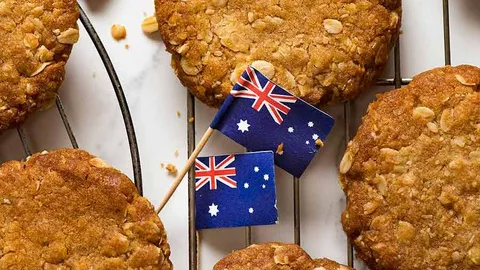isess2013.org – Anzac biscuits are a beloved treat with a rich history and a delightful, crunchy texture. These cookies, made with oats, golden syrup, and coconut, are a staple in Australian and New Zealand households. In this article, we will explore the origins, traditional ingredients, preparation methods, and cultural significance of Anzac biscuits.
Origins of Anzac Biscuits
Anzac biscuits date back to World War I, with their name derived from the acronym ANZAC, which stands for the Australian and New Zealand Army Corps. These biscuits were sent to soldiers overseas because they were made with ingredients that did not spoil easily, making them ideal for long voyages. Unlike many other baked goods, Anzac biscuits do not contain eggs, which were scarce during wartime. Instead, they rely on golden syrup as a binding agent, contributing to their unique flavor and texture.
Traditional Ingredients
The classic Anzac biscuit recipe includes simple, pantry-friendly ingredients: rolled oats, flour, sugar, desiccated coconut, butter, golden syrup, baking soda, and boiling water. The oats provide a hearty base, while the coconut adds a subtle sweetness and chewiness. Golden syrup, a key ingredient, imparts a rich, caramel-like flavor that distinguishes Anzac biscuits from other cookies. The combination of these ingredients creates a biscuit that is both crunchy and satisfying.
Preparation Methods
Making Anzac biscuits is a straightforward process that involves combining the dry ingredients—rolled oats, flour, sugar, and coconut—in a large bowl. In a separate saucepan, butter and golden syrup are melted together, then mixed with a solution of baking soda dissolved in boiling water. This wet mixture is then stirred into the dry ingredients to form a dough. Small portions of the dough are shaped into balls and flattened slightly before baking. The biscuits are baked until golden brown, resulting in a crispy exterior and a slightly chewy interior.
Cultural Significance
Anzac biscuits hold a special place in the hearts of Australians and New Zealanders. They are traditionally baked to commemorate Anzac Day on April 25th, a day of remembrance for soldiers who served and died in wars and conflicts. The biscuits symbolize the resourcefulness and resilience of those who lived through wartime, and they continue to be a popular treat enjoyed year-round. Anzac biscuits are often shared at community gatherings, school events, and family celebrations, reinforcing their role in cultural identity and heritage.
Conclusion
Anzac biscuits, with their delightful crunch and heartwarming history, remain a cherished part of Australian and New Zealand culture. Their simple ingredients and easy preparation make them accessible to bakers of all skill levels, while their connection to Anzac Day adds a layer of significance to their enjoyment. Whether shared with friends and family or savored alone with a cup of tea, Anzac biscuits continue to bring comfort and joy to those who bake and eat them.

